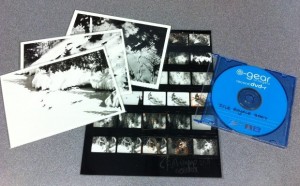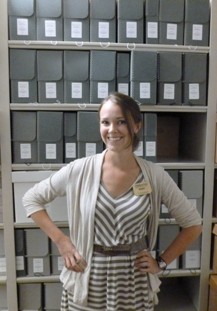As this year’s graduate summer intern at the Archives, I’ve come a long way this summer. I mean this both in terms of distance (over 1500 miles from Austin, Texas!) and in my knowledge and appreciation of the Copper Country. While working with the staff here and with the collections, I’ve learned much more about copper mining than I ever imagined I would ever want or need to know. It is safe to say that I’ve grown fond of this area and its unique history.
My project this summer was to process the Ecological Studies of Wolves on Isle Royale Collection. The Isle Royale wolf-moose project has been ongoing for over 50 years now, studying the relationship between moose and wolf populations on the secluded island.

While working with the collection, I was fascinated in how the research and record-keeping practices changed over the decades, both with changes in leadership and with changes in technology. Early manuscripts in the collection were edited by physically cutting and taping type-written pages, while later manuscripts were edited in a word processor. Hand-drawn graphs similarly became computerized, and photographs changed to digital formats. Perhaps some things in field research will withstand technological changes–I simply can’t imagine an iPad taking the place of a field notebook. Technology loses its charms when removed from other modern conveniences on a remote island wilderness.
Aside from its ties to Michigan Tech, the wolf-moose project may seem to be in a world all its own, far removed from the Copper Country. But my experiences this summer have led me to believe that this is far from true. Isle Royale and the Keweenaw Peninsula sit, like two peas in a pod, on each end of the Lake Superior basin. They are each unique in their own right, through their history, geology and ecology. And yet they share, at least in my mind, a pristine quality and sense of mystery. Surely they have secrets yet to be uncovered.

The Ecological Studies of Wolves on Isle Royale Collection contains correspondence, administrative records, data collection files, manuscripts, reports, and publications. The bulk of materials date from 1957-1999, covering Durward L. Allen’s and Rolf O. Peterson’s leads on the project. The collection is quite varied in format, including annual reports, photos, raw film footage, field guides, 169 field notebooks, newspaper and journal articles, and maps of Isle Royale. Whether you are interested in ecological research, the history of this study, or the more personal side of the project, there is something for everyone in this collection.
A striking example of scholarship and professionalism at its best. This young lady must truly be destined for greatness. I haven’t seen this much potential in an archivist since Margaret C. Norton!